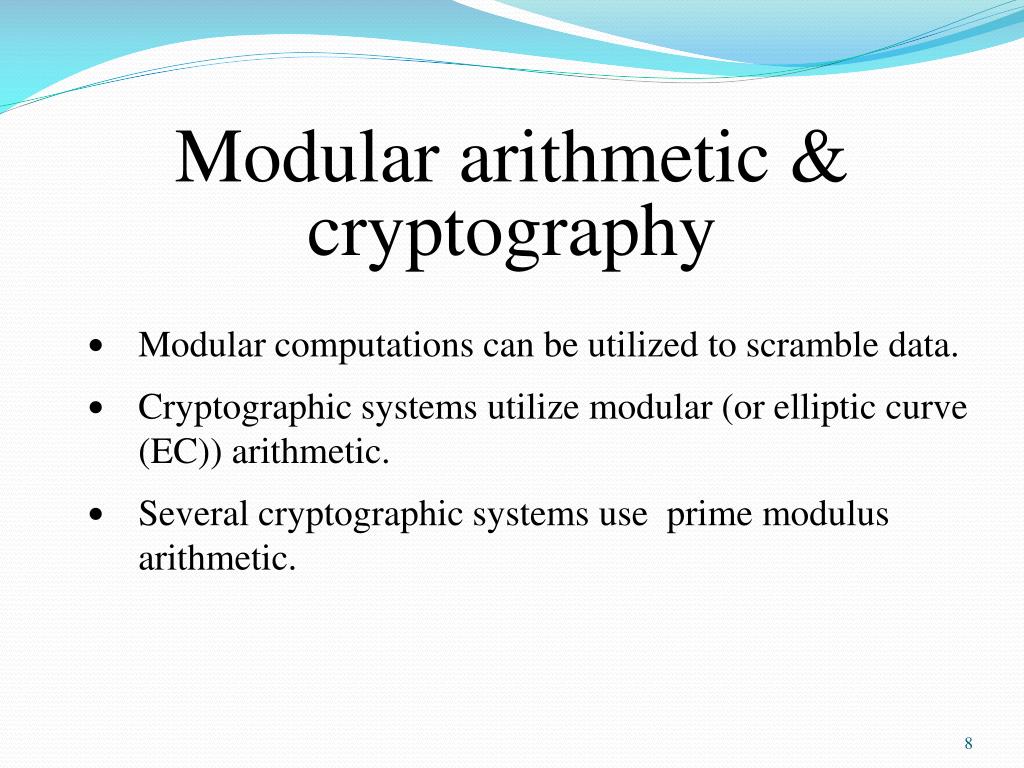In the intricate realm of cryptography, where security and secrecy intertwine, modular arithmetic emerges as a crucial cornerstone upon which modern cryptographic systems are built. At its essence, modular arithmetic provides a mathematical framework that enables secure communication, safeguarding data from prying eyes. This discussion aims to demystify modular arithmetic, elucidate its applications in cryptography, and explore how it reshapes our understanding of secure communications.
To begin, one must grasp the fundamental principles of modular arithmetic. This mathematical discipline involves integers and the concept of “wrap-around” behavior when numbers exceed a specified value, known as the modulus. For instance, when working in modulo 5 arithmetic, the numbers wrap around after reaching 4. Therefore, 5 becomes 0, 6 becomes 1, and so forth. This cyclical property is not merely a mathematical curiosity; it becomes the bedrock for designing cryptographic algorithms.
Modular arithmetic is particularly potent in the context of public-key cryptography, a paradigm that offers enhanced security compared to traditional symmetric-key methods. In public-key systems, users possess a pair of keys: a public key, which anyone can access, and a private key, known only to the owner. This duality enables secure exchanges of information, even between parties that have never met before. However, the security of such systems hinges on the mathematical difficulty of certain operations, primarily facilitated by modular arithmetic.
Consider the RSA algorithm, one of the most widely used cryptographic methods. RSA relies on the mathematical challenge of factoring large numbers into their prime components. Its implementation rests on choosing two large prime numbers, multiplying them to create a modulus, and establishing relationships between public and private keys via modular exponentiation. The crux of the RSA algorithm lies in the sheer difficulty of prime factorization. While multiplying two large primes is computationally trivial, reversing that operation—factoring the product back into its prime constituents—becomes a monumental task as the size of the numbers increases. This asymmetry is what provides RSA its strength, and modular arithmetic is the vehicle that drives this innovation.
Another significant aspect of modular arithmetic in cryptography is the concept of discrete logarithms, which is foundational to various cryptographic protocols such as the Diffie-Hellman key exchange. The discrete logarithm problem involves finding an exponent when given a base and a result within a finite group structure, typically established through modular arithmetic. The infeasibility of efficiently solving this problem lends formidable security to key exchange mechanisms, as it ensures that even an eavesdropper, intercepting the exchange of numbers, cannot glean the shared secret without the requisite information.
The interplay between modular arithmetic and cryptography further extends to digital signatures and hashing algorithms. Digital signatures, which authenticate electronic documents, utilize modular arithmetic to create verifiable signatures from a message and a private key. Hashing algorithms, which produce fixed-size outputs from varying input data, often employ modular operations to ensure that even the minutest change in input results in a drastically different hash. This property is crucial for integrity verification across digital communications.
Yet, as with any mathematical system, modular arithmetic is not without its vulnerabilities. Challenges arise from mathematical constructs such as the Chinese Remainder Theorem and the security of the underlying primes used in cryptographic systems. As computational technology advances, the risks associated with smaller key sizes become more pronounced. Cryptographers thus continuously push for larger key sizes and more complex mathematical structures to fortify security against potential threats, notably from quantum computing, which showcases an ability to solve previously insurmountable problems efficiently.
A notable evolution in the field is the advent of post-quantum cryptography, driven by the understanding that modular arithmetic must be adaptable. The insights gained from traditional approaches lay the groundwork for innovative algorithms that resist quantum attacks, emphasizing the dynamic relationship between mathematical theory and practical application in security.
In summation, modular arithmetic serves as an essential mechanism in cryptography, underpinning the security protocols that protect our digital lives. From its foundational role in the RSA algorithm to its applications in key exchanges and digital signatures, it reveals a remarkable capability to secure communication. As the landscape of technology continues to evolve, so too will the strategies that leverage modular arithmetic to thwart emerging threats. Therefore, a shift in perspective is warranted: modular arithmetic is not merely a mathematical abstraction but a vital instrument in the ongoing quest for robust cryptographic security. In recognizing this, one piques their curiosity about the mathematical intricacies that govern modern digital communication, inviting further exploration into the ways in which numbers can be manipulated to create security in an increasingly interconnected world.









Leave a Comment